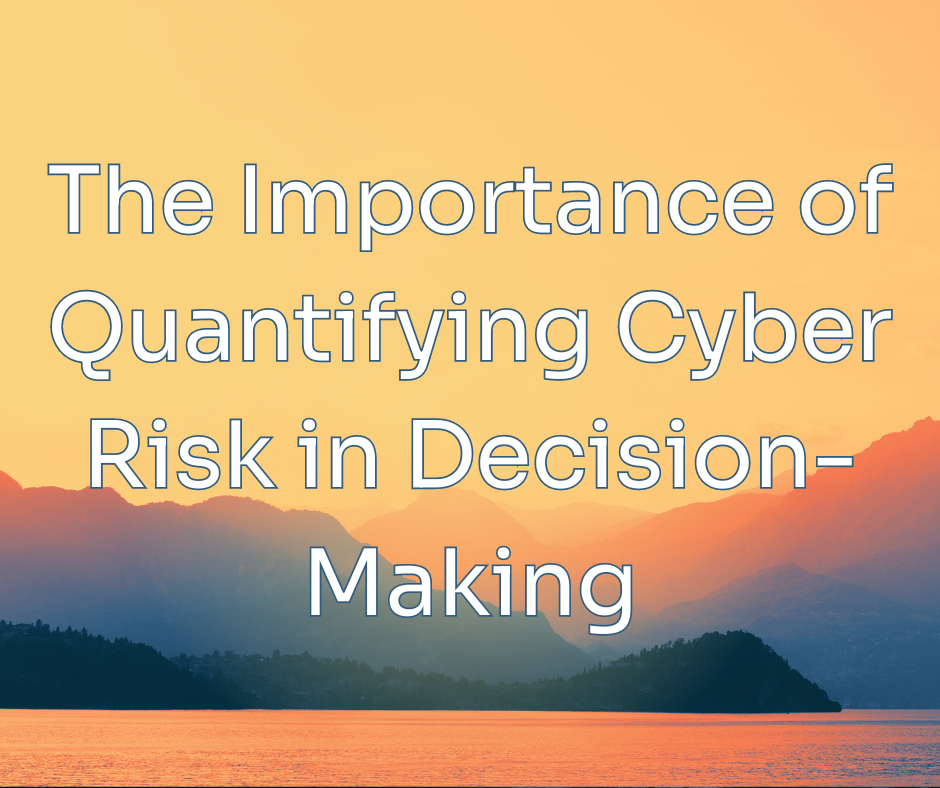Posted
When making cybersecurity decisions, like ‘where to apply my investments,’ CISOs, executives, and boards rely on various insights and data points. Cyber risk quantification (CRQ) allows decision-makers to make data-driven, objective, and defensible decisions and enables more effective discussions between the CISO and business leaders.
If you want to make business decisions as informed as possible, quantitative risk analysis is an essential tool in your arsenal. Let’s take a closer look at this concept and how you can use it to make data-driven cybersecurity decisions.
What Is Cyber Risk Quantification and Why is it Important?
Risk quantification measures an organization’s risks in the same financial terms used to make business decisions, while qualitative risk analysis offers more subjective insights into the characteristics of risks. Quantitative analysis is more rigorous and comprehensive, providing detailed insights and actionable data. CRQ uses a combination of data and analytics to contextualize business assets and produce quantitative outputs through dashboards, visualizations, and reports.
Risk quantification in cybersecurity aims to answer questions like:
- What is the potential cost of a data breach to our organization?
- How much would it cost to reduce risk by a specific amount?
- How do I prioritize the remediation of exposures within the bounds of available resources?
Some of the most common reasons why companies quantify risk in cybersecurity are to provide the means to facilitate cyber risk discussions, minimize losses to the business due to cyber events, and address regulatory requirements in highly regulated industries and publicly traded companies.
The Benefits of Cyber Risk Quantification
Here are a few reasons why you need to quantify cybersecurity risks:
1. Objective, data-driven analysis
While qualitative assessments have had their place, cybersecurity is complex. Quantification provides objective outputs, enabling direct comparisons across industries, peers, and lines of business. You don’t need to guess what someone means or determine their criteria for labeling something “high risk.” It minimizes confusion by providing objectivity and clarifies differing interpretations, misunderstandings, and miscommunication.
Although much of risk quantification focuses on an event’s financial impact (or loss), it can also provide valuable insights into the financial exposure of other business areas, like operations. For example, it helps answer questions such as “What are the most critical applications to the business, and why?” and “Which vulnerabilities are truly a critical risk to the business?”.
2. Improved Communication
CRQ helps stakeholders align due to the clarity of the available information. Cybersecurity can often seem nebulous and vague to people who don’t have an expert level of knowledge and understanding, which is problematic as cybersecurity is so varied, wide-ranging, and complex. Individuals often struggle to communicate its complexity and impact on the business effectively and may diminish the impact of cybersecurity needs, leading to misaligned or, in the worst case, wrong decisions. CRQ puts cyber risks in financial terms that executives, leaders, and other individuals can all understand.
With better communication, stakeholders can make well-aligned and better-informed decisions that adequately convey cybersecurity risks. With CRQ, they are now enabled to discuss threats in a way that makes sense to everyone, regardless of their level of knowledge or understanding of the cybersecurity landscape. For example, executives can easily understand how important an investment in a new threat detection and response solution is due to the financial exposure introduced by the deficiencies in the currently deployed solution. Where “high risk” is somewhat subjective, a quantitative assessment shows the estimated costs a security breach would impose on the organization and facilitates more meaningful discussions about cybersecurity’s impact on the business and how investing in a new solution would be cost-beneficial for the business.
3. Aggregation of Dynamic or Big-Picture Risks
Cybersecurity risks are constantly increasing due to the adoption of new technologies and services, creating more exposures in the business’ attack surface that are being exploited by a growing number, sophistication, and persistence of threat actors with different motivations. The complexity of a business environment makes quantification an effective way to evaluate all threats that could materialize as risks. Aggregating qualitative findings to see their cumulative effects is nearly impossible to do in an accurate manner that drives action. Quantitative analysis provides a practical way to aggregate and understand the financial exposure of cyber risks across the organization.
4. Informed Prioritization
Every organization has risks, and some have more than others. If they didn’t, they wouldn’t be in business. Quantitative analysis provides the details required to understand and prioritize the most impactful risks to the business. Shift your focus on risk prioritization from subjective ratings to metrics that drive the business and are prioritized easily by financial exposure. Furthermore, organizations can incorporate the cost of risk remediations to drive prioritization via Return On Investment (ROI). Risk quantification provides actionable data, reducing the emotion and friction when discussing cyber risks.
Understand the Cost of Cyber Risks With ThreatConnect Risk Quantifier (RQ)
Risk quantification doesn’t need to be a time-consuming, complex process. ThreatConnect’s Risk Quantifier (RQ) solution quickly produces actionable risk insights to help with better decision-making and communications. The solution requires minimal implementation as it does all the heavy lifting and quickly produces results that you can then evaluate and critique. If you’ve already started your cyber risk quantification journey using the FAIR model, RQ allows you to continue using your preferred approach and provides two additional models (semi-automated FAIR and machine learning) that scale with your organization as your CRQ requirements evolve.
Contact us to speak to one of our experts or get a demo to understand how ThreatConnect RQ can help you evolve your cyber risk management program, remove the barriers to communicating cyber risks, and make better, more effective, data-driven decisions.
